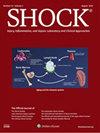重大热损伤后的纤溶功能障碍和内皮病变:烧伤休克复苏新方法需要考虑的因素。
IF 2.7
3区 医学
Q2 CRITICAL CARE MEDICINE
引用次数: 0
摘要
近年来,多达 40% 的患者在热损伤后数小时内会出现纤溶功能障碍和内皮病变,这显然与不良预后和更高的复苏要求有关。烧伤后,纤溶系统迅速被激活,一般来说,随着损伤严重程度的增加,激活程度也会增加。血浆中极高浓度的纤溶酶-抗纤溶酶复合物(活化标志物)与死亡率有关。根据粘弹性测定法的评估,患者表现出纤维蛋白溶解亢进、生理性/正常或纤维蛋白溶解不足/纤维蛋白溶解关闭表型。在急性烧伤复苏期间,50% 以上的患者的表型会发生变化,其中一些模式(适应不良)与死亡风险增加有关,而另一些模式(适应性,趋向于生理表型)则与存活有关。血浆中辛迪加-1 浓度升高所反映的内皮病变也与死亡率升高有关。在此,我们回顾了烧伤后这些反应的发生率和影响,并探讨了其机制以及与早期炎症反应的潜在相互作用。烧伤和非烧伤创伤的现有数据表明,纤溶系统、内皮系统和炎症系统之间存在广泛的相互作用,其中一个系统的失调可能会加剧其他系统的失调。因此,成功治疗其中一个系统可能会对其他系统产生有利影响。本文章由计算机程序翻译,如有差异,请以英文原文为准。
Fibrinolytic Dysfunction and Endotheliopathy After Major Thermal Injury: Considerations Needed for New Approaches to Burn Shock Resuscitation.
In recent years, it has become apparent that fibrinolytic dysfunction and endotheliopathy develop in up to 40% of patients during the first hours following thermal injury and are associated with poor outcomes and increased resuscitation requirements. Rapidly following burn injury, the fibrinolytic system is activated, with activation generally greater with increased severity of injury. Very high plasma concentrations of plasmin-antiplasmin complex (marker of activation), have been associated with mortality. Patients display hyperfibrinolytic, physiologic/normal or hypofibrinolytic/fibrinolytic shutdown phenotypes, as assessed by viscoelastic assay. Phenotypes change in over 50% of patients during the acute burn resuscitation period, with some patterns (maladaptive) associated with increased mortality risk and others (adaptive, trending toward the physiologic phenotype) associated with survival. Endotheliopathy, as reflected in elevated plasma concentrations of syndecan-1 has also been associated with increased mortality. Here we review the incidence and effects of these responses after burn injury and explore mechanisms and potential interactions with the early inflammatory response. Available data from burn and non-burn trauma suggest that the fibrinolytic, endothelial, and inflammatory systems interact extensively and that dysregulation in one may exacerbate dysregulation in the others. This raises the possibility that successful treatment of one may favorably impact the others.
求助全文
通过发布文献求助,成功后即可免费获取论文全文。
去求助
来源期刊

SHOCK
医学-外科
CiteScore
6.20
自引率
3.20%
发文量
199
审稿时长
1 months
期刊介绍:
SHOCK®: Injury, Inflammation, and Sepsis: Laboratory and Clinical Approaches includes studies of novel therapeutic approaches, such as immunomodulation, gene therapy, nutrition, and others. The mission of the Journal is to foster and promote multidisciplinary studies, both experimental and clinical in nature, that critically examine the etiology, mechanisms and novel therapeutics of shock-related pathophysiological conditions. Its purpose is to excel as a vehicle for timely publication in the areas of basic and clinical studies of shock, trauma, sepsis, inflammation, ischemia, and related pathobiological states, with particular emphasis on the biologic mechanisms that determine the response to such injury. Making such information available will ultimately facilitate improved care of the traumatized or septic individual.
 求助内容:
求助内容: 应助结果提醒方式:
应助结果提醒方式:


